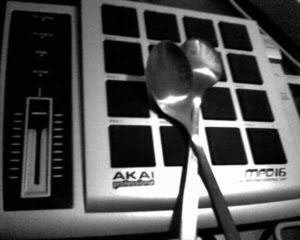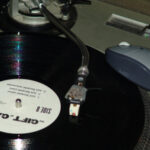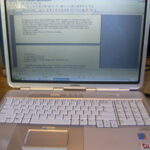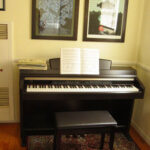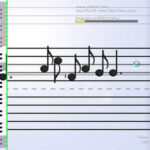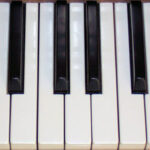The Akai MPD16 was recommended to me by one of the pro audio salesman at Guitar Center in Pasadena, CA. Since I already use a feature-rich Firewire audio-controller/ MIDI sequencer, the M-Audio Ozonic, I did not need a complicated piece of hardware.
I wanted something with singleness of purpose: I was tired of banging out my drum parts on keyboard keys on my Compaq Presario, or even using the piano-style keys on the Ozonic. The Akai MPD16 USB/ MIDI Control Pad gives the user access to 16 pressure-sensitive pads that have an excellent feel. The Akai Web site says they are the same as those on the MPC series of drum synths and controllers, and that is saying a lot. That line is known and widely-employed by musicians everywhere for drum programming needs.
But, I didn’t want to spend hundreds of dollars on something with features redundant to those of a piece of equipment I already had. The Akai MPD16 fits the bill, and at a discounted $99 (you should be able to find it at or close to this price from Musicians Friend or similar sites) it was a great value.
I use Ableton Live as a software-based sequencing and recording program, in addition to Audacity for clipping and editing samples. Getting the Akai MPD16 to interface with Abelton Live was not quite as simple as I had hoped, but with a little digging on the Ableton forums, I found a way to assign each pad to the values used by each of the drums in Impulse, Ableton Live’s built in drum sequencer.
Once I found the right numbers (someone with more knowledge of MIDI will have no trouble coming up with these), assigning the values was very easy using the device editor included on the install CD.
As far as the physical hardware and drivers installation, it couldn’t be easier. Just connect the Akai to an available USB port and insert the CD. A wizard does the rest. If you want to use the device editor, you’ll need to view the contents of the CD and copy it on to your hard drive, and then install.
I’ve read on the forums that Mac users have had a slightly more difficult time setting up the Akai MPD16 with their computers, but with my Compaq Presario laptop (AMD Turion 64×2 1.67 GhZ, Windows XP, 1 gig of ram) it was easy.
As far as latency, an extremely important issue in drum controllers, the Akai MPD16 score pretty well, as long as I was using the sound card on the M-Audio Ozonic to handle inputs and outputs. The Akai MPD16, interestingly enough, did not come with an AC Adaptor of any kind. The device runs off USB power with no problems, but if you want to incorporate into your MIDI rack directly using the built-in MIDI output and a cable, rather than running USB directly into your computer, you will need to purchase the optional AC Adaptor, which lists for $19.99.
Once I was able to interface with Ableton Live, I was beating out some great drum lines in no time! The documentation says the drum pads on the Akai MPD16 have 157 levels of pressure sensitivity, plus velocity sensitivity. I was able to play with a lot of expression very easily, indeed someone asked if it was a live drummer on one of my tracks, and I know comparatively little about audio production.
There are also lots of tricky things you can do with the Akai MPD16, such as cuing samples, starting and stopping each individual track or loop or recording to the master. There are two separate banks, giving you a total of 32 usable triggers at your disposal without having to touch your computer or make any edits to the device.
My only gripe regarding the MPD16, other than the lack of an included AC adaptor, is that the paper and online documentations are severely lacking. There is no reason why an inexperienced user such as myself should have to go to online forums to research how to set up the device. I can’t comment on durability yet, as I have only owned the Akai MPD16 for a few weeks.
Overall, I would give the Akai MPD16 device high marks as an inexpensive software-based recording and performance tool.
